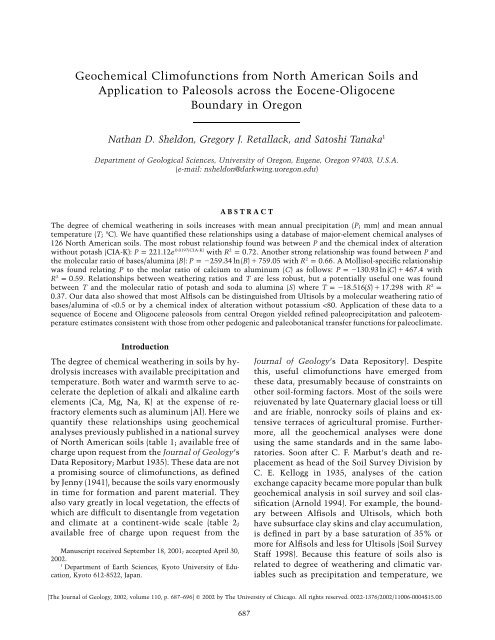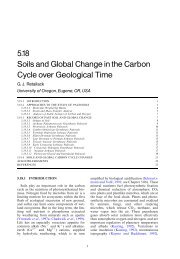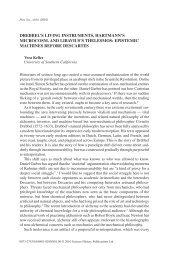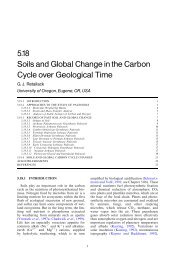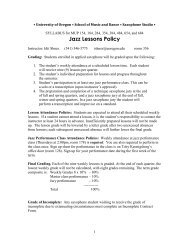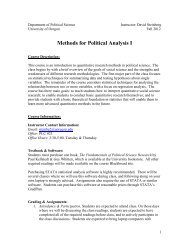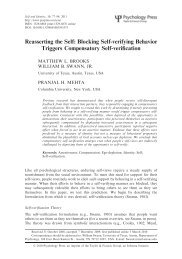Geochemical Climofunctions from North American Soils and ...
Geochemical Climofunctions from North American Soils and ...
Geochemical Climofunctions from North American Soils and ...
- No tags were found...
You also want an ePaper? Increase the reach of your titles
YUMPU automatically turns print PDFs into web optimized ePapers that Google loves.
<strong>Geochemical</strong> <strong>Climofunctions</strong> <strong>from</strong> <strong>North</strong> <strong>American</strong> <strong>Soils</strong> <strong>and</strong>Application to Paleosols across the Eocene-OligoceneBoundary in OregonNathan D. Sheldon, Gregory J. Retallack, <strong>and</strong> Satoshi Tanaka 1Department of Geological Sciences, University of Oregon, Eugene, Oregon 97403, U.S.A.(e-mail: nsheldon@darkwing.uoregon.edu)ABSTRACTThe degree of chemical weathering in soils increases with mean annual precipitation (P; mm) <strong>and</strong> mean annualtemperature (T; C). We have quantified these relationships using a database of major-element chemical analyses of126 <strong>North</strong> <strong>American</strong> soils. The most robust relationship found was between P <strong>and</strong> the chemical index of alteration0.0197(CIA-K) 2without potash (CIA-K): P p 221.12e with R p 0.72. Another strong relationship was found between P <strong>and</strong>2the molecular ratio of bases/alumina (B): P p 259.34 ln (B) 759.05 with R p 0.66. A Mollisol-specific relationshipwas found relating P to the molar ratio of calcium to aluminum (C) as follows: P p 130.93 ln (C) 467.4 with2R p 0.59. Relationships between weathering ratios <strong>and</strong> T are less robust, but a potentially useful one was foundbetween T <strong>and</strong> the molecular ratio of potash <strong>and</strong> soda to alumina (S) where T p 18.516(S) 17.298 with R 2 p0.37. Our data also showed that most Alfisols can be distinguished <strong>from</strong> Ultisols by a molecular weathering ratio ofbases/alumina of !0.5 or by a chemical index of alteration without potassium !80. Application of these data to asequence of Eocene <strong>and</strong> Oligocene paleosols <strong>from</strong> central Oregon yielded refined paleoprecipitation <strong>and</strong> paleotemperatureestimates consistent with those <strong>from</strong> other pedogenic <strong>and</strong> paleobotanical transfer functions for paleoclimate.IntroductionThe degree of chemical weathering in soils by hydrolysisincreases with available precipitation <strong>and</strong>temperature. Both water <strong>and</strong> warmth serve to acceleratethe depletion of alkali <strong>and</strong> alkaline earthelements (Ca, Mg, Na, K) at the expense of refractoryelements such as aluminum (Al). Here wequantify these relationships using geochemicalanalyses previously published in a national surveyof <strong>North</strong> <strong>American</strong> soils (table 1; available free ofcharge upon request <strong>from</strong> the Journal of Geology’sData Repository; Marbut 1935). These data are nota promising source of climofunctions, as definedby Jenny (1941), because the soils vary enormouslyin time for formation <strong>and</strong> parent material. Theyalso vary greatly in local vegetation, the effects ofwhich are difficult to disentangle <strong>from</strong> vegetation<strong>and</strong> climate at a continent-wide scale (table 2;available free of charge upon request <strong>from</strong> theManuscript received September 18, 2001; accepted April 30,2002.1Department of Earth Sciences, Kyoto University of Education,Kyoto 612-8522, Japan.Journal of Geology’s Data Repository). Despitethis, useful climofunctions have emerged <strong>from</strong>these data, presumably because of constraints onother soil-forming factors. Most of the soils wererejuvenated by late Quaternary glacial loess or till<strong>and</strong> are friable, nonrocky soils of plains <strong>and</strong> extensiveterraces of agricultural promise. Furthermore,all the geochemical analyses were doneusing the same st<strong>and</strong>ards <strong>and</strong> in the same laboratories.Soon after C. F. Marbut’s death <strong>and</strong> replacementas head of the Soil Survey Division byC. E. Kellogg in 1935, analyses of the cationexchange capacity became more popular than bulkgeochemical analysis in soil survey <strong>and</strong> soil classification(Arnold 1994). For example, the boundarybetween Alfisols <strong>and</strong> Ultisols, which bothhave subsurface clay skins <strong>and</strong> clay accumulation,is defined in part by a base saturation of 35% ormore for Alfisols <strong>and</strong> less for Ultisols (Soil SurveyStaff 1998). Because this feature of soils also isrelated to degree of weathering <strong>and</strong> climatic variablessuch as precipitation <strong>and</strong> temperature, we[The Journal of Geology, 2002, volume 110, p. 687–696] 2002 by The University of Chicago. All rights reserved. 0022-1376/2002/11006-0004$15.00687
688 N. D. SHELDON ET AL.have identified bulk geochemical criteria for thisimportant taxonomic division.Much of the motivation for this study comes<strong>from</strong> the search for climofunctions <strong>and</strong> taxonomiccriteria suitable for use in the paleoenvironmentalinterpretation of paleosols (Retallack 1994, 1997,2001b). Base saturation <strong>and</strong> cation exchange capacityof soils are not preserved in paleosols <strong>and</strong>are substantially altered soon after burial (Retallack1991), but the bulk chemical composition of paleosolsappears to be robust in the face of diagenetic(Mora et al. 1998) <strong>and</strong> even metamorphic alteration(Barrientos <strong>and</strong> Selverstone 1987). In the secondpart of this study, we test the identified climofunctionsusing chemical data <strong>from</strong> paleosols (Retallacket al. 2000). Although the climofunctionsfound lack precision, we judge them worthwhile tothe extent that they demonstrate significant paleoclimatictrends that are supported by other proxypaleoclimatic evidence <strong>from</strong> paleosols (Retallack1994; Retallack et al. 2000) <strong>and</strong> fossil plants (Manchester1994; Meyer <strong>and</strong> Manchester 1997).Material <strong>and</strong> MethodsAll the chemical analyses of soils used were publishedby Marbut (1935). He published data obtained<strong>from</strong> different portions of the soils (colloidvs. whole soil). We used the portion of the dataobtained <strong>from</strong> whole soil analyses after the soil hadbeen oven dried at 110C. Because of burial compaction(e.g., Sheldon <strong>and</strong> Retallack 2001) <strong>and</strong> diagenesis,it is difficult to impossible to separate onlythe colloidal fraction of a paleosol. We reformulatedthe data as molecular weathering ratios by dividingeach weight percent by the molecular weight of theoxide in question, giving us relative abundance onan atomic stoichiometric basis rather than on thebasis of weights (Retallack 1997, 2001b). Climaticdata were drawn <strong>from</strong> stations within 20 miles ofeach of the soil sites (Hare <strong>and</strong> Thomas 1974; Ruffner1980). For each site, we also determined thecurrent soil series <strong>and</strong> profile name as well as itsidentification in Keys to Soil Taxonomy (Soil SurveyStaff 1998) of the United States Soil ConservationService by consulting a wide array of publishedsoil surveys (tables 1, 2). Table 1 consists ofsoil classifications <strong>and</strong> climatic data. Table 2 listsvegetative cover, topography, parent material, <strong>and</strong>estimated formation time for each of the soils. Wescanned <strong>and</strong> plotted this large database using computerspreadsheets to identify any significant relationshipsbetween chemical <strong>and</strong> climatic data ina much more comprehensive manner than in ourprevious attempts to analyze these same data(Tegge 1986; Ready <strong>and</strong> Retallack 1995).Constraints on <strong>Climofunctions</strong> for <strong>North</strong><strong>American</strong> <strong>Soils</strong>The accuracy of climofunctions depends on a wellconstrainedclimosequence, defined by Jenny (1941)as a set of soils varying in climate but showing littlevariation in other soil-forming variables such as vegetation,soil animals, topographic relief, parent material,<strong>and</strong> time for formation. A well-constrainedclimofunction would have to be confined to a limitedarea in order to avoid changes in vegetation thataccompany climatic variation, but such geographicrestriction also limits its usefulness for applicationto paleosols. An example is Jenny’s (1941) classicclimofunction of mean annual precipitation <strong>and</strong>depth to calcic horizon in grassl<strong>and</strong> soils on postglacialloess of the <strong>North</strong> <strong>American</strong> central GreatPlains. A comparably accurate climofunction betweenprecipitation <strong>and</strong> depth to calcic horizon canbe obtained if the choice of soils is relaxed to thosewith nodular carbonate (not wispy or tabular) on friable,loamy to gravelly, sedimentary parent materialsof varied chemical composition in climatesranging <strong>from</strong> the Tropics to the Poles (Retallack1994). However, the relationship rapidly falls apartwhen exp<strong>and</strong>ed to soils with tabular carbonate onhillslopes prone to erosion <strong>and</strong> on hard bedrock parentmaterials (Royer 1999; Retallack 2000). This isregrettable because a relationship between depth tocalcic horizon <strong>and</strong> precipitation for hillslope <strong>and</strong>bedrock soils would be useful, <strong>and</strong> failure of the relationshipfor steeply sloping soils limits its universalapplication.From this perspective, Marbut’s (1935) selectionof soils used here is not a well-constrained climosequence.It ranges over many soil-forming variables(table 2), so that any statistically significantrelationship emerging should be of widespread applicability.The database is best constrained fortopographic relief <strong>and</strong> parent material texture becauseemphasis on widespread <strong>and</strong> agriculturallyimportant soils focused attention on well-drained,loamy soils without abundant gravel or shallowbedrock, on rolling plains <strong>and</strong> extensive terraces.Parent materials vary considerably <strong>from</strong> volcanicash to basaltic-<strong>and</strong>esitic gravel <strong>and</strong> deeply weatheredgranite, but this variation is not as wide asit could have been because of the widespread influenceof calcareous postglacial loess in mostparts of the continent. Vegetation of the soils includesdesert scrub, sagebrush grassl<strong>and</strong>s, cooltemperate grassl<strong>and</strong>s, broadleaf woodl<strong>and</strong>s, <strong>and</strong>
Journal of Geology GEOCHEMICAL SOIL CLIMOFUNCTIONS 689conifer forests. Time for formation also varies<strong>from</strong> l<strong>and</strong> surfaces only a few thous<strong>and</strong> years oldon desert playas <strong>and</strong> coastal s<strong>and</strong> plains to surfacesmillions of years old on bedrock terraces. Althoughthe variation in time for formation, parentmaterial, <strong>and</strong> vegetation gives our climofunctionspotentially widespread application, we do not expectthem to perform beyond the parameters ofthe climosequence. Australia, for example, lacksactive volcanoes <strong>and</strong> has large flat areas of geochemicallymature soils <strong>and</strong> rocks quite different<strong>from</strong> <strong>North</strong> America (Ollier <strong>and</strong> Pain 1996).We tried different horizons, depth functions, <strong>and</strong>parent-corrected formulations of the data as well asa variety of molecular weathering ratios <strong>and</strong> foundthe best climofunctions emerged <strong>from</strong> the chemicalcomposition of the subsurface (Bt or Bw) horizon.Molecular weathering ratios for surface horizons, ratiosbetween horizons, <strong>and</strong> between key variables asa function of depth did not perform as well in oursystematic search for statistically significant relationships.In addition to new relationships, we reassessedprevious formulations including the chemicalindex of alteration (Nesbitt <strong>and</strong> Young 1982;Maynard 1992) <strong>and</strong> the molecular ratio of bases toalumina (Retallack 1997, 2001b).<strong>Climofunctions</strong>Nesbitt <strong>and</strong> Young (1982) proposed the chemicalindex of alteration (CIA) as a measurement of thedegree of rock weathering. It is calculated by takingthe molar ratio of Al 2 O 3 to Al 2O3 CaO Na 2O KO(alumina, 2lime, soda, <strong>and</strong> potash) <strong>and</strong>multiplying it by 100. Alkalies are found predominantlyin feldspars <strong>and</strong> micas, so the CIA is a measurementof the breakdown of those types of minerals.A stoichiometric albite has a CIA value of50, <strong>and</strong> a stoichiometric anorthite has a CIA valueof 33. Maynard (1992) suggested calculating theCIA without potash (CIA-K) to control for the effectsof potassium metasomatism in paleosols. Forapplication to paleosols, we have chosen to useCIA-K values in place of CIA values. In both Maynard’s(1992) original data <strong>and</strong> in the Marbut (1935)data, there is an extremely strong correlation2( R p 0.97) between CIA <strong>and</strong> CIA-K values. Maynard(1992) also suggested an index of the weatheringof Mg-bearing minerals calculated by multiplyingthe molar ratio of Al 2 O 3 to Al2O3 MgO by100.Retallack (1997, 2001b) has suggested that themolecular ratio of MgO CaO Na 2O KO 2 toAl 2 O 3 calculated <strong>from</strong> oxides is an effective measurementof the degree of weathering because basesare the primary cations lost during weathering. Onepotential disadvantage of this approach is that Mgis generally hosted in different minerals than Ca,Na, <strong>and</strong> K (Maynard 1992). However, it is a morecomprehensive measurement of base loss duringweathering.Among our various trials, the most robust relationshipfound was between mean annual precipitation(P; mm) <strong>and</strong> the chemical index of alterationwithout K (CIA-K):0.0197(CIA-K)P p 221e , (1)2which has reasonable accuracy ( R p 0.72). Alternatively,it can be related linearly byP p 14.265(CIA-K) 37.632 (2)2with slightly higher accuracy ( R p 0.73). The resultsobtained by these two fits are broadly similar(fig. 1), but the exponential fit is favored for theoreticalreasons because it comes closer to capturingthe asymptote at CIA-K p 100 (i.e., kaolinite). Thisrelationship reflects higher precipitation leading tomore intense chemical weathering, which preferentiallyremoves the alkali <strong>and</strong> alkaline earth elementswhile leaving refractory elements such asaluminum in place. Low CIA-K values occur insoils with low P due to the accumulation of Ca <strong>and</strong>Mg in Bk horizons or the accumulation of Ca <strong>and</strong>Na in evaporite minerals. These base cations arenot readily removed when there is little chemicalweathering. The equation relating CIA-K to precipitationis useful over a precipitation range of200–1600 mm/yr using the exponential fit (eq. [1]).A CIA-K value of 100 yields a precipitation esti-Figure 1. Relationship between mean annual precipitation<strong>and</strong> CIA-K in a national survey of <strong>North</strong> <strong>American</strong>soils (Marbut 1935).
690 N. D. SHELDON ET AL.a potentially useful relationship between the molarratio of lime to alumina (C) <strong>and</strong> P:P p 130.93 ln (C) 467.4, (4)Figure 2. Relationship between mean annual precipitation<strong>and</strong> the molecular ratio of CaO MgO Na2O KOto 2 Al 2 O 3 in a national survey of <strong>North</strong> <strong>American</strong> soils(Marbut 1935).mate of 1585 mm <strong>and</strong> represents a soil that wascomposed largely of kaolinite <strong>and</strong> refractory mineralssuch as Fe <strong>and</strong> Al sesquioxides as in an Oxisolor lateritic soil. This relationship is not usefullyapplied to soils with near-surface carbonate or evaporiteminerals like those found in desert soils, noris it useful for soils that are thick <strong>and</strong> composedonly of highly weathered minerals such as kaolinite,gibbsite, <strong>and</strong> boehmite (as in a laterite). Thisrelationship also does not apply to swamps, bogs,<strong>and</strong> other waterlogged ground, eolian dunes, groundfreshly disturbed by human activities, or hillslope<strong>and</strong> montane soils.While the Mg-index of Maynard (1992) shows acomparable correlation with P, we favor the molecularratio of bases to alumina because low- orhigh-Mg soils (e.g., basalt-parent soils) give unlikelyor impossible paleoprecipitation estimates. Themolar ratio of bases to alumina (B) is also related2to P with comparable accuracy ( R p 0.66) to CIA-K as follows:2where R p 0.59 (fig. 3). In wetter Mollisols, Ca canbe readily weathered. In drier settings, Ca is lessreadily leached <strong>and</strong> accumulates in Bk horizons givinghigher CaO to Al 2 O 3 ratios.Attempts to relate molecular weathering ratiosto mean annual temperature (T; C) yield less robust2relationships ( R ! 0.5). One potentially useful relationship(fig. 4) was found between T <strong>and</strong> molecularratio of Na 2 O <strong>and</strong> K 2 OtoAl 2 O 3 (S):T p 18.516(S) 17.298, (5)2again with reasonable accuracy ( R p 0.37). In spite2of the low R value, this relationship, like those forprecipitation, is significant at the 99.9% level( t p 8.5154, F p 72.58). The useful T range for thisrelationship is approximately 2–20C. At highertemperatures, most Na <strong>and</strong> K are leached nearlycompletely. Many desert soils show up-profile augmentationof both Na (in evaporite minerals) <strong>and</strong>K (K-bearing minerals are less readily weatheredthan Ca- or Mg-bearing minerals) <strong>and</strong> have low T’sbecause of extreme seasonality (Retallack 2001b).A logarithmic fit to the data is comparably accurate<strong>and</strong> better predicts high temperatures but fails topredict lower temperatures <strong>and</strong> would only be usefulfor 8–22C. This relationship should not beused for frigid soils with frost heave structures, patternedground, <strong>and</strong> other features of polar soils(Washburn 1980; Bockheim 1997), nor for deeplyweathered thick kaolinitic soils of tropical regions(Ollier <strong>and</strong> Pain 1996). As for the other climofunc-P p 259.34 ln (B) 759.05. (3)This relationship is also useful for 200–1600 mm/yr P (fig. 2). While it could theoretically predicthigher precipitation values, the analytical uncertaintiesin analyses of such low amounts of weatherablebases make it unsuitable for precipitation inexcess of 1600 mm/yr. As for CIA-K (eqq. [1], [2]),this relationship is not useful for desert soils, waterloggedsoils, disturbed soils, or soils forming onsignificant topographic relief.Mollisols are grassl<strong>and</strong> soils that are unknownin the geologic record before the Cenozoic (Retallack2001a). Plotting of Mollisol data alone yieldedFigure 3. Relationship between mean annual precipitation<strong>and</strong> the molecular ratio of CaO to Al 2 O 3 of Mollisolsin a national survey of <strong>North</strong> <strong>American</strong> soils (Marbut1935).
Journal of Geology GEOCHEMICAL SOIL CLIMOFUNCTIONS 691tions above, this one also should not be used forswampy, eolian, disturbed, or hillslope soils.<strong>Geochemical</strong> Criteria for <strong>North</strong> <strong>American</strong>Soil ClassificationWhile readily identifiable <strong>and</strong> diagnostic featuresare often preserved in paleosols, distinguishingamong some modern soil orders can be difficult.For this reason, we looked for molecular weatheringratios that are able to distinguish among soilorders. Table 3 compares Alfisols, Ultisols, <strong>and</strong>Mollisols. While identification of a Mollisol requiresa mollic epipedon, table 3 demonstrates thatthey are also chemically distinct <strong>from</strong> the two forestsoil orders. This comparison also shows thatwhile one of the primary differences between modernAlfisols <strong>and</strong> Ultisols is l<strong>and</strong>scape stability (i.e.,formation time between disturbances), mean annualtemperature <strong>and</strong> mean annual precipitationconditions are also significantly different. In <strong>North</strong>America both precipitation <strong>and</strong> temperature decreasein the order Ultisol 1 Alfisol 1 Mollisol. Further,there is no overlap in CIA-K values of Alfisols<strong>and</strong> Ultisols within 1 SD of their respective means<strong>and</strong> only a slight overlap between base to aluminaratio means, plus (or minus) 1 SD. This suggeststhat both CIA-K <strong>and</strong> bases/alumina molecular ratiosare useful in distinguishing Alfisols <strong>from</strong> Ultisols.Our data show that most Ultisols, unlikeAlfisols, typically have a molecular weathering ratioof bases/alumina of !0.5. This corresponds to amolar ratio of alumina/bases of 12, often muchgreater for Ultisols <strong>and</strong> Oxisols (Retallack 1997).The most prominent exceptions are Alfisols onlimestone in Tennessee (tables 1, 2; #18) <strong>and</strong> granitein Oregon (#126) <strong>and</strong> an Ultisol on glauconitic marines<strong>and</strong> in coastal Maryl<strong>and</strong> (#12). In each case,induration or unusually mafic parent materials explainthe anomaly because these can limit both vegetation<strong>and</strong> weathering (Retallack 2001b).Both CIA-K of 180 <strong>and</strong> the molecular ratio ofbases/alumina of 0.5 can be considered proxies forthe official criterion of 35% base saturation usedin soil taxonomy to divide Alfisols with higher basesaturation <strong>from</strong> Ultisols with lower values (SoilSurvey Staff 1998). The relationship between basesaturation <strong>and</strong> rainfall was examined for soils ofthe <strong>North</strong> <strong>American</strong> Great Plains by Jenny (1941),who found that it increased <strong>from</strong> a minimum insoils at 300 mm mean annual precipitation to amaximum in soils at 660 mm <strong>and</strong> then declinedtoward higher rainfalls. Scott (1962) produced acomparable curve for tropical Kenya, where becauseof much higher evapotranspiration, cationFigure 4. Relationship between mean annual temperature<strong>and</strong> molecular weathering ratio of KO 2 Na2OtoAl 2 O 3 in a national survey of <strong>North</strong> <strong>American</strong> soils (Marbut1935).exchange capacity of soils peaked at a mean annualprecipitation of 1170 mm. Comparable relationshipsover a shorter range of precipitation have alsobeen found in Natal (Donkin <strong>and</strong> Fey 1993) <strong>and</strong>New Zeal<strong>and</strong> (McIntosh et al. 1983). In both <strong>North</strong>America <strong>and</strong> Kenya, cation exchange capacity islimited in aridl<strong>and</strong> soils because of their lack ofclay that provides most sites of ionic exchange insoils. Cation exchange is also limited in soils ofvery humid climates because their clays have a lowcontent of alkali <strong>and</strong> alkaline earth cations as aresult of long <strong>and</strong> profound weathering (Folkoff1987). Our curve of base depletion with rainfall (fig.2) is a proxy for the downward slope of this curveat high rainfalls but not the upward slope at lowrainfalls. Using our preferred climofunction (fig. 1),we reach the critical CIA-K of 80 at a rainfall of1069 mm. The isohyet boundary between Alfisols<strong>and</strong> Ultisols in the southeastern United States isclose to 1200 mm, where Alfisols persist on maficparent materials alongside Ultisols on felsic parentmaterials (Markewich et al. 1990). In tropicalKenya, with much higher evapotranspiration, basesaturation of !35% is mainly found in soils ofregions receiving 11700 mm mean annual precipitation(Scott 1962), <strong>and</strong> this isohyet effectivelyoutlines the low-fertility forest soils (Acrisols, Nitosols,<strong>and</strong> Ferralsols of Sombroek et al. 1982).Several other proxies of base saturation useful forpaleosol classification have been suggested by Nettletonet al. (1998, 2000), who found a relationshipbetween weatherable minerals (W as percent of silt<strong>and</strong> s<strong>and</strong>) <strong>and</strong> base saturation (C as percent of totalcations) ofW p 0.284C 7.1 (6)
692 N. D. SHELDON ET AL.Table 3. Comparison of Mean Annual Precipitation (MAP), Mean Annual Temperature (MAT), Chemical Index ofAlteration without Potassium (CIA-K), <strong>and</strong> the Molecular Ratio of Bases/Alumina (B/Al) for Alfisols, Mollisols, <strong>and</strong>Ultisols of <strong>North</strong> AmericaSoil type MAP j MAT j CIA-K j B/Al jAlfisol (n p 27) 991 196 11.1 3.6 69.1 8.1 .61 .19Mollisol (n p 30) 582 181 9.4 3.6 51.4 16.1 1.38 .9Ultisol (n p 51) 1239 138 16.2 2.5 87.4 8.9 .24 .232with low accuracy ( R p 0.27, n p 258). The proportionof weatherable minerals needed for an Alfisolusing this relationship is at least 15% in veryfine s<strong>and</strong> or coarse silt fractions.Dust <strong>and</strong> RejuvenationPerhaps the biggest surprise of this study is thatrobust relationships could emerge <strong>from</strong> such variedparent materials <strong>and</strong> times for formation. These aresuch strong controls on soil formation that onewould expect uncorrelated scatter plots of geochemicalcompositions <strong>and</strong> soil forming variables.A variety of processes are rejuvenating <strong>and</strong> homogenizing<strong>North</strong> <strong>American</strong> soils. Volcanic ash<strong>and</strong> eolian dust are the primary agents of renewalin <strong>North</strong> <strong>American</strong> soil formation (Brimhall et al.1988; McFadden et al. 1991), especially the voluminousMount St. Helens <strong>and</strong> Mazama ashes of the<strong>American</strong> West (Busacca et al. 1992) <strong>and</strong> the Wisconsinanloess <strong>and</strong> till of the Midwest <strong>and</strong> northeasternUnited States (Ruhe 1984; Šibrava et al.1986). Bedrock soils near glacial ice margins arecommonly scraped clean by glacial advances <strong>and</strong>,even where never glaciated, may have been deeplyfractured <strong>and</strong> renewed by frost cracking (Ciolkoszet al. 1990). Many paleokarst terranes on Paleozoiclimestones have been renewed by slope wash <strong>from</strong>surrounding s<strong>and</strong>stone <strong>and</strong> siltstone as well as <strong>from</strong>dustings of postglacial loess (Ruhe <strong>and</strong> Olson 1980).Even in humid, warm bedrock terraces of the southeasternUnited States remote <strong>from</strong> glacier termini<strong>and</strong> loess, downward weathering into fresh rockprovides an upper limit to soil age of about 3 millionyears (Markewich et al. 1989). Soil formationincludes much alteration of minerals in place, butsoils are homogenized continent-wide by influxesof eolian dust <strong>and</strong> volcanic ash, by frost cracking<strong>and</strong> glacial scouring, <strong>and</strong> by continued downwardweathering.Another surprise is that the best relationshipsemerged <strong>from</strong> subsurface (Bw or Bt) horizon compositionrather than surface (A) or deep (C) horizonsor profile depth function parameters. This also canbe seen as a validation of eolian models of soilbuilding (Brimhall et al. 1988; McFadden et al.1991), in which B horizon material tends to be of3 5a geological age (some 10 –10 yr), older than materialstill accumulating at the surface <strong>and</strong> youngerthan materials deeper in the profile that in somecases remains <strong>from</strong> geologically much earlier periodsof weathering. The B horizon can be consideredto have a mean residence time that averagesout short-term surficial disruptions <strong>and</strong> additionsas well as deeper residual accumulation.Less surprising is the emergence of taxonomicallyrelevant geochemical criteria <strong>from</strong> our databecause the Alfisol-Ultisol division was first designedto apply to <strong>North</strong> <strong>American</strong> soils (Arnold1994). Nevertheless, temporal <strong>and</strong> lithological dependenceof United States soil orders is notable inour data (tables 1, 2). In general, Ultisols are foundon old l<strong>and</strong>scapes <strong>and</strong> felsic, noncalcareous parentmaterials like those of the southeastern UnitedStates (Markewich et al. 1989, 1990), but Alfisolsoccur on young l<strong>and</strong>scapes <strong>and</strong> mafic, calcareousparent materials like those of the midwesternUnited States (Ruhe 1984; Holliday 1990). Thereare exceptions that reflect individual soil histories.Unlike climofunctions in which competing factorsare minimized, soil taxonomic criteria reflect thecurrent condition of the soil as a compromise ofinteracting factors.Application of Transfer Functions to Eocene <strong>and</strong>Oligocene Paleosols of OregonCentral Oregon has thick sequences of nonmarinevolcaniclastic sedimentary rocks, which includemany hundreds of paleosols ranging in geologicalage back to the Paleocene. These rocks have longbeen famous for their terrestrial fossils, which havebeen important for underst<strong>and</strong>ing the evolution ofplants <strong>and</strong> mammals through the past 45 millionyears, particularly the well-known evolution ofhorses (Retallack et al. 1996). The plant fossils providemuch information on paleoclimate, by virtueof their botanical affinities <strong>and</strong> foliar physiognomy(Leopold et al. 1992; Manchester 1994; Meyer <strong>and</strong>Manchester 1997). Using such well-known climofunctionsas depth to calcic horizon as a guide topaleoprecipitation (Retallack 1994), we can add in-
Journal of Geology GEOCHEMICAL SOIL CLIMOFUNCTIONS 693Figure 5. Estimated paleoprecipitation <strong>and</strong> paleotemperature <strong>from</strong> a sequence of Eocene <strong>and</strong> Oligocene paleosolsin central Oregon (data <strong>from</strong> Retallack et al. 2000). Error bars are <strong>from</strong> calculated st<strong>and</strong>ard error <strong>and</strong> represent 182mm <strong>and</strong> 4.4Cformation <strong>from</strong> paleosols to this paleontologicalrecord (Retallack et al. 2000). These paleosols providea good test of the climofunctions identifiedhere (figs. 1, 2) because paleoclimatic variation predictedby these climofunctions can be comparedwith other paleoclimatic proxies <strong>from</strong> fossil soils<strong>and</strong> plants.There are now measured sections <strong>and</strong> chemicaldata available for paleosols in the Clarno Formationof middle to late Eocene age (45–39 Ma) in theClarno area <strong>and</strong> in the lower John Day Formationof the Painted Hills of late Eocene to Oligocene age(37–28 Ma) in central Oregon (Retallack et al. 2000).These formations represent volcanic back-arc lowl<strong>and</strong>deposits of lakes, streams, <strong>and</strong> mudflows, includingmany paleosols. Geological dating in thesesequences is supported by numerous high-precision39Ar/ 40 Ar single-crystal laser-fusion radiometricdates (Retallack et al. 1996; Bestl<strong>and</strong> et al. 1997,1999) <strong>and</strong> <strong>from</strong> biostratigraphy of mammal fossils(Uintan-Arikareean of fig. 5; Prothero 1998).The climofunctions presented here (figs. 1, 2, 4)can be applied to Bt horizons of these paleosols(fig. 5) <strong>and</strong> show a significant climatic break at theEocene-Oligocene boundary (33.7 Ma), when conditionsbecame both cooler <strong>and</strong> drier than before.Climate was evidently wet <strong>and</strong> warm (11000 mm<strong>and</strong> 112C) with some cooler <strong>and</strong> drier spells duringthe Eocene. During the Oligocene, however, rainfallfluctuated between about 600 <strong>and</strong> 800 mm, <strong>and</strong>mean annual temperatures between 5–12C (fig. 5).Paleoprecipitation estimates for central Oregonpaleosols <strong>from</strong> chemical data presented here (fig. 5)are strikingly confirmed by paleoprecipitation es-
694 N. D. SHELDON ET AL.timates <strong>from</strong> depth to calcic horizon in the samepaleosols (fig. 6). This is a very close correspondencebetween several very different paleoclimaticproxies derived <strong>from</strong> paleosols.Also confirmed are paleoclimatic indications<strong>from</strong> fossil plants. Warm, humid conditions formiddle Eocene floras of this region are indicated byhigh specific diversity, abundant vines, tropicaltaxa such as palms (Sabalites) <strong>and</strong> Magnolia, <strong>and</strong>large, entire-margined leaves with drip tips. Manchester(1994) proposed a mean annual temperatureof 20–25C <strong>and</strong> a humid rainfall regime during themiddle Eocene for central Oregon. Leopold et al.(1992) suggested late Eocene “woody savanna” conditions,implying 900–1500 mm mean annual precipitationfor much of the intermontane West, withsubstantial drying in the early Oligocene. Cooltemperate humid conditions are apparent <strong>from</strong>early Oligocene floras of the region because of theirlower diversity, deciduous taxa such as oaks (Quercus)<strong>and</strong> elms (Ulmus), <strong>and</strong> smaller leaves with dentatemargins. Meyer <strong>and</strong> Manchester (1997) proposea mean annual temperature of 3–11C for the earlyOligocene (32 Ma). These <strong>and</strong> other estimates(Wolfe 1995) are all quite close to those <strong>from</strong> thetransfer functions outlined here <strong>and</strong> give confidencein their utility for paleoclimatic reconstruction<strong>from</strong> paleosols.Figure 6. Comparison of paleoprecipitation estimates<strong>from</strong> multiple proxies <strong>from</strong> Late Oligocene paleosols ofcentral Oregon (data <strong>from</strong> Retallack et al. 2000). Our newpaleoprecipitation estimates fall within 1 SD (141 mm)of paleoprecipitation estimates <strong>from</strong> depth to the Bk horizonin contemporaneous paleosols.ConclusionsOur analysis of chemical data on 126 representative<strong>North</strong> <strong>American</strong> soils <strong>from</strong> the last national surveyof soil bulk chemical composition (Marbut 1935)has shown at least four robust climofunctions betweenthe chemical index of alteration without K<strong>and</strong> mean annual precipitation (fig. 1), the molecularratio of base/alumina in the B horizon <strong>and</strong>mean annual precipitation (fig. 2), between the molecularratio of lime to alumina in Mollisols <strong>and</strong>mean annual precipitation (fig. 3), <strong>and</strong> between thesoda <strong>and</strong> potash to alumina ratio <strong>and</strong> mean annualtemperature (fig. 4). Many other relationships wereexplored <strong>and</strong> found to be of little statistical significance.The fact that any reasonable climofunctionrelationship should emerge <strong>from</strong> soils of such disparatevegetation, parent materials, topographicsetting, <strong>and</strong> time for formation is surprising butalso encouraging. The relationships that we haveuncovered are robust enough to be applied to manypaleosols but are not unlimited in their applicabilityto soils of swamps, deserts, or deeply weatheredtropical regions.An implication of the muted effect of differencesin soil age <strong>and</strong> parent material in compromisingour climofunctions is that volcanic ash <strong>and</strong> eoli<strong>and</strong>ust plays a role in homogenizing the chemicalcomposition of soil Bt horizons in <strong>North</strong> America(McFadden et al. 1991). Although the equations wehave derived are not as precise as we would like,they are adequate for some applications, such asthe paleoclimatic interpretation of paleosols. Wefound that estimates of paleoprecipitation <strong>and</strong> paleotemperature<strong>from</strong> chemical data using the equationspresented here gave results consistent withother paleopedological (Retallack et al. 2000) <strong>and</strong>paleobotanical (Manchester 1994; Meyer <strong>and</strong> Manchester1997) evidence <strong>from</strong> fossiliferous paleosolsranging in age <strong>from</strong> 45–28 million years old in centralOregon.ACKNOWLEDGMENTSWe thank B. Tegge <strong>and</strong> D. Ready, who revealed theinitial promise of this approach. G. J. Retallack wasfunded by the National Parks Service, <strong>and</strong> both N.D. Sheldon <strong>and</strong> G. J. Retallack were funded by NationalScience Foundation grant EAR-0000953 forwork on paleosols in central Oregon. We also thankS. Driese for a helpful review.
Journal of Geology GEOCHEMICAL SOIL CLIMOFUNCTIONS 695REFERENCESCITEDArnold, R. W. 1994. Soil geography <strong>and</strong> factor functionality:interacting concepts. In Amundson, R.; Harden,T.; <strong>and</strong> Singer, M., eds. Factors of soil formation—afiftieth anniversary retrospective. Soil Sci. Soc. Am.Spec. Publ. 33:99–109.Barrientos, X., <strong>and</strong> Selverstone, J. 1987. Metamorphosedsoils as stratigraphic indicators in deformed terranes:an example <strong>from</strong> the eastern Alps. Geology 15:841–844.Bestl<strong>and</strong>, E. A.; Hammond, P. E.; Blackwell, D. L. S.; Retallack,G. J.; <strong>and</strong> Stimac, J. 1999. Geologic frameworkof the Clarno Unit, John Day Fossil Beds NationalMonument, central Oregon. Oreg. Geol. 61:3–19.Bestl<strong>and</strong>, E. A.; Retallack, G. J.; <strong>and</strong> Swisher, C. C. 1997.Stepwise climate change recorded in Eocene-Oligocenepaleosol sequences <strong>from</strong> central Oregon. J. Geol.105:153–172.Bockheim, J. G. 1997. Properties <strong>and</strong> classification of colddesert soils <strong>from</strong> Antarctica. Soil Sci. Soc. Am. J. 61:224–231.Brimhall, G. H.; Lewis, C. J.; Ague, J. J.; Dietrich, W. E.;Hampel, J.; Teague, T.; <strong>and</strong> Rix, P. 1988. Metal enrichmentin bauxites by deposition of chemically matureaeolian dust. Nature 333:819–824.Busacca, A. J.; Nelstead, K. T.; McDonald, E. V.; <strong>and</strong>Purser, M. D. 1992. Correlation of distal tephra layersin loess in the Channeled Scabl<strong>and</strong> <strong>and</strong> Palouse ofWashington State. Quat. Res. 37:281–303.Ciolkosz, E. J.; Carter, B. J.; Hoover, M. T.; Cronce, R.C.; Waltman, W. J.; <strong>and</strong> Dobos, R. R. 1990. Genesis ofsoils <strong>and</strong> l<strong>and</strong>scapes in the Ridge <strong>and</strong> Valley Provinceof central Pennsylvania. Geomorphology 3:245–261.Donkin, M. J., <strong>and</strong> Fey, M. V. 1993. Relationships betweensoil properties <strong>and</strong> climatic indices in southernNatal. Geoderma 59:197–212.Folkoff, M. E. 1987. Climatic control of soil acidity inthe B horizon of United States soils. Phys. Geogr. 8:82–97.Hare, F. K., <strong>and</strong> Thomas, M. K. 1974. Climate Canada.Toronto, Wiley of Canada, 256 p.Holliday, V. T. 1990. <strong>Soils</strong> <strong>and</strong> l<strong>and</strong>scape evolution ofeolian plains: the southern High Plains of Texas <strong>and</strong>New Mexico. Geomorphology 3:489–515.Jenny, H. J. 1941. Factors in soil formation. New York,McGraw-Hill.Leopold, A. B.; Liu, G.-W.; <strong>and</strong> Clay-Poole, S. 1992. Lowbiomass vegetation in the Oligocene? In Prothero, D.R., <strong>and</strong> Berggren, W. A., eds. Eocene-Oligocene climatic<strong>and</strong> biotic evolution. Princeton, N.J., PrincetonUniversity Press, p. 399–420.Manchester, S. R. 1994. Fruits <strong>and</strong> seeds of the middleEocene nut beds flora, Clarno Formation, Oregon. Palaeontogr.Am. 58:1–205.Marbut, C. F. 1935. Atlas of <strong>American</strong> agriculture. III.<strong>Soils</strong> of the United States. Washington, D.C., GovernmentPrinting Office.Markewich, H. W.; Pavich, M. J.; <strong>and</strong> Buell, G. R. 1990.Contrasting soils <strong>and</strong> l<strong>and</strong>scapes of the Piedmont <strong>and</strong>Coastal Plain, eastern United States. In McFadden, L.D., <strong>and</strong> Kneupfer, P. L. K., eds. <strong>Soils</strong> <strong>and</strong> l<strong>and</strong>scapeevolution. Geomorphology 3:417–447.Markewich, H. W.; Pavich, M. J.; Mausbach, M. J.; Hall,R. L.; Johnson, R. G.; <strong>and</strong> Hearn, P. P. 1989. Age relationsbetween soils <strong>and</strong> geology of the coastal plainof Maryl<strong>and</strong> <strong>and</strong> Virginia. U.S. Geol. Surv. Bull.1589A:1–34.Maynard, J. B. 1992. Chemistry of modern soils as a guideto interpreting Precambrian paleosols. J. Geol. 100:279–289.McFadden, L. D.; Amundson, R. G.; <strong>and</strong> Chadwick, O.A. 1991. Numerical modeling, chemical, <strong>and</strong> isotopicstudies of carbonate accumulation in soils of aridregions. In Nettleton, W. D., ed. Occurrence, characteristics,<strong>and</strong> genesis of carbonate, gypsum <strong>and</strong> silicaaccumulations in soils. Soil Sci. Soc. Am. Spec.Publ. 26:17–35.McIntosh, P. D.; Lee, W. D.; <strong>and</strong> Banks, T. 1983. Soildevelopment <strong>and</strong> vegetation trends along a rainfallgradient on the East Otago upl<strong>and</strong>s. N. Z. J. Sci. 26:379–401.Meyer, H. W., <strong>and</strong> Manchester, S. R. 1997. The OligoceneBridge Creek flora of the John Day Formation, Oregon.Univ. Calif. Publ. Geol. Sci. 141:1–195.Mora, C. I.; Sheldon, B. T.; Elliott, W. C.; <strong>and</strong> Driese, S.G. 1998. An oxygen isotope study of illite <strong>and</strong> calcitein three Appalachian vertic paleosols. J. Sediment.Res. A68:456–464.Nesbitt, H. W., <strong>and</strong> Young, G. M. 1982. Early Proterozoicclimates <strong>and</strong> plate motions inferred <strong>from</strong> major elementchemistry of lutites. Nature 299:715–717.Nettleton, W. D.; Brasher, B. R.; Benham, E. L.; <strong>and</strong> Ahrens,R. J. 1998. A classification system for buried paleosols.In Follmer, L. R.; Johnson, D. L.; <strong>and</strong> Catt, J.A., eds. Revisitation of concepts in paleopedology:transactions of the Second International Symposiumon Paleopedology. Quat. Int. 51/52:175–183.Nettleton, W. D.; Olson, C. G.; <strong>and</strong> Wysocki, D. A. 2000.Paleosol classification: problems <strong>and</strong> solutions. Catena41:61–69.Ollier, C., <strong>and</strong> Pain, C. 1996. Regolith, soils <strong>and</strong> l<strong>and</strong>forms.Chichester, Wiley.Prothero, D. R. 1998. The chronological, climatic <strong>and</strong>paleogeographic background to <strong>North</strong> <strong>American</strong>mammalian evolution. In Janis, C. M.; Scott, K. M.;<strong>and</strong> Jacobs, L. L., eds. Evolution of Tertiary mammalsof <strong>North</strong> America. 1. Terrestrial carnivores, ungulates<strong>and</strong> ungulatelike mammals. Cambridge, CambridgeUniversity Press, p. 1–36.Ready, C. D., <strong>and</strong> Retallack, G. J. 1995. Chemical compositionas a guide to paleoclimate of paleosols. Geol.Soc. Am. Abstr. 27:A237.Retallack, G. J. 1991. Untangling the effects of burial
696 N. D. SHELDON ET AL.alteration <strong>and</strong> ancient soil formation. Annu. Rev.Earth Planet. Sci. 19:183–206.———. 1994. The environmental factor approach to theinterpretation of paleosols. In Amundson, R.; Harden,J.; <strong>and</strong> Singer, M., eds. Factors of soil formation—afiftieth anniversary retrospective. Soil Sci. Soc. Am.Spec. Publ. 33:31–64.———. 1997. A colour guide to paleosols. Chichester,Wiley, 175 p.———. 2000. Depth to pedogenic carbonate horizon asa paleoprecipitation indicator? comment <strong>and</strong> reply.Geology 28:572–573.———. 2001a. Cenozoic expansion of grassl<strong>and</strong>s <strong>and</strong> climaticcooling. J. Geol. 109:407–426.———. 2001b. <strong>Soils</strong> of the past: an introduction to paleopedology(2d ed.). Oxford, Blackwell Science, 404 p.Retallack, G. J.; Bestl<strong>and</strong>, E. A.; <strong>and</strong> Fremd, T. J. 1996.Reconstructions of Eocene <strong>and</strong> Oligocene plants <strong>and</strong>animals of central Oregon. Oreg. Geol. 58:51–69.———. 2000. Eocene <strong>and</strong> Oligocene paleosols of centralOregon. Geol. Soc. Am. Spec. Pap. 344:1–192.Royer, D. L. 1999. Depth to pedogenic carbonate horizonas a paleoprecipitation indicator? Geology 27:1123–1126.Ruffner, J. H. 1980. Climates of the states (3d ed.). Detroit,Gale Research.Ruhe, R. V. 1984. Soil climate system across the prairiesof midwestern USA. Geoderma 34:201–219.Ruhe, R. V., <strong>and</strong> Olson, C. G. 1980. The origin of terrarossa in the karst of southern Indiana. In Shaver, R.,ed. Field trips 1980 <strong>from</strong> the Indiana University campus,Bloomington. Bloomington, Ind., Department ofGeology, Indiana University, p. 84–122.Scott, R. M. 1962. Exchangeable bases of mature, welldrainedsoils in relation to rainfall in East Africa. J.Soil Sci. 13:1–9.Sheldon, N. D., <strong>and</strong> Retallack, G. J. 2001. Equation forcompaction of paleosols due to burial. Geology 29:247–250.Šibrava, V.; Bowen, D. Q.; <strong>and</strong> Richmond, G. H., eds.1986. Quaternary glaciations in the <strong>North</strong>ern Hemisphere.Quat. Sci. Rev. 5:1–510.Soil Survey Staff. 1998. Keys to soil taxonomy. Blacksburg,Va., Pocahontas.Sombroek, W. G.; Braun, H. M. H.; <strong>and</strong> van der Pouw, B.J. A. 1982. Exploratory soil map <strong>and</strong> agroclimatic zonemap of Kenya, 1980. Nairobi, Kenya Soil Survey, scale1 : 1,000,000.Tegge, B. J. 1986. A preliminary study of the relationshipsbetween precipitation <strong>and</strong> the abundance <strong>and</strong> distributionof potassium within selected Unites Statessoils. Proc. Oreg. Acad. Sci. 22:35.Washburn, A. L. 1980. Geocryology. New York, Wiley.Wolfe, J. A. 1995. Paleoclimatic estimates <strong>from</strong> Tertiaryleaf assemblages. Annu. Rev. Earth Planet. Sci. 23:119–143.


